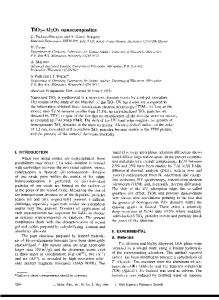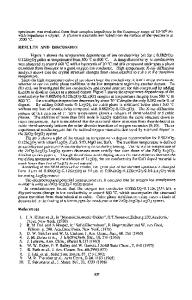Experimental Investigation of the Viscosities in CaO-SiO 2 -MgO-Al 2 O 3 and CaO-SiO 2 -MgO-Al 2 O 3 -TiO 2 Slags
- PDF / 249,882 Bytes
- 5 Pages / 593.972 x 792 pts Page_size
- 48 Downloads / 373 Views
TRODUCTION
IN the case of the blast furnace process, the slag viscosity is a very important physical property, because its influences the furnace operation in many ways. The viscosity of the slag affects the gas permeability, heat transfer, reduction of SiO2 and FeO, etc. It is desirable to search for slag systems, which can provide good fluidity even at low temperatures. There are several data reported on the viscosity of blast furnace slags.[1–3] However, most of these data are mainly for low alumina slags with alumina in the range of 10 to 15 pct. Further, these viscosity data represent slags with high CaO/SiO2 ratio; very high amounts of additives such as FeO,[4] TiO2,[5] Fe2O3,[3] etc.; and with limited temperature range. These are generally unusual in blast furnace operations as deduced from the final slag composition. From an applied viewpoint, it is necessary to study the viscosity of multicomponent slag systems with a wide range of slag constituents and a wide temperature range. The range of temperatures should cover the liquidus temperature, because the viscosity at this temperature will fluctuate greatly. In the present work, the slag viscosity was experimentally determined for CaO-SiO2-MgO-Al2O3 and CaO-SiO2-MgO-Al2O3-TiO2 slags. These slags correspond to high alumina blast furnace slags. Alumina was varied between 20 and 30 pct, MgO between 2 and AMITABH SHANKAR, Researcher, is with Research and Development, Tata Steel, Jamshedpur-831 001, India. Contact e-mail: [email protected], [email protected]. MA˚RTEN GO¨RNERUP, Research Associate, and S. SEETHARAMAN, Professor, are with the Department of Material Science and Engineering, Royal Institute of Technology, Stockholm-100 44, Sweden. A.K. LAHIRI, formerly Professor, Department of Metallurgy, Indian Institute of Science, Bangalore-560 012, India, is currently a Consultant to many organizations. Manuscript submitted February 14, 2007. Article published online October 23, 2007. METALLURGICAL AND MATERIALS TRANSACTIONS B
5 pct, TiO2 between 0 and 2 pct, and CaO/SiO2 between 0.8 and 1.2. The temperature range of the investigation was between 1650 and 1873 K. The effects of Al2O3, MgO, and TiO2 on the viscosities of the preceding slag systems were investigated. The present objective was to create a data base for the viscosity of high alumina blast furnace slags, so that a suitable viscosity model can be formulated in order to optimize the blast furnace slags with a wide range of temperature and slag chemistry.
II.
EXPERIMENTAL
A. Apparatus for Viscosity Measurement In the present work, viscosity measurements were made by the rotating cylinder method using a Brookfield digital viscometer (model LVDV-II+ Pro).The experimental setup for the viscosity measurement is shown in Figure 1, which consists of a viscometer and a high-temperature furnace. This furnace was a Laboratory Furnace Group 1000, supplied by Thermal Technology Inc. (Santa Rosa, CA). The furnace had a specially designed graphite heating element, which was controlled by a Eurotherm cont
Data Loading...











